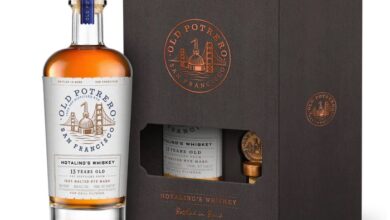Q&A With Maureen Robinson, Diageo Master Blender
By Richard Thomas

“Women in whisky” as a thing has become almost passe. There are so many women’s whisk(e)y clubs around the world that I often wonder why anyone thinks of female enthusiasts as novel, and a surge of women have taken leading creative roles across the industry in recent years. Behind the latter development were a few trailblazers, who spent decades establishing themselves in a business run by men and for a male clientele. In the Scotch whisky industry, one of the women synonymous with “trailblazer” is Maureen Robinson.
RT: You are a Master Blender at Diageo, but at Diageo several people have that title. You are best known for your work with Talisker and Lagavulin, but your responsibilities are actually wider ranging. So first off, could you tell us a bit about what falls into your portfolio?
MR: I have the best job in the company – I’m responsible for creating some the world’s favorite whisky: Scotch! Day to day, I manage a team of five people. Our main focus is on Scotch innovation, renovation and, ultimately making sure our blends are consistently brilliant through both nose and taste.
All of this involves in depth knowledge about the whisky making process; distilling, maturation, blending and so on. One of my favorite parts of the role is liquid creation which involves having second-to-none access of Diageo’s extensive Scotch portfolio.
RT: A lot of Diageo releases have your fingerprints on them. Can you name a few that you are most proud of?
MR: One of my major achievements is ‘The Singleton’ Scotch Whisky, especially Singleton of Glen Ord in Asia and my ultimate pride and joy is getting my signature on the bottle of some of the expressions.
I am also proud of Buchanan’s Red Seal, which has my signature on it as well and of course the annual Special Scotch Releases, this year’s selection of ten rare bottlings is especially brilliant.
RT: When you are creating a new expression, there are two requirements to balance off each other. One is keeping the identity of the distillery or brand, but against this is crafting an expression that is distinctive in its own right. In your long career, were there any instances where checking off both those boxes proved particularly difficult?
MR: At Diageo we have over nine million casks from various distilleries, ages and wood profiles so we are spoilt for choice. This, alongside a team of blenders with decades of experience, allows us the luxury of ticking both boxes.
RT: You recently marked 40 years in the whisky industry, and you’ve held the role of Master Blender since 1986. Whisky is perceived as an industry wedded to its traditions, but of course a lot of things evolve over time. Looking back on when you were starting out in the late ’70s and the ’80s — the Thatcher years, I guess you could say – can you think of any new practice or event from back then that turned out to be very important and far reaching for today’s industry?
MR: The job has changed over the years, which has been exciting and in my opinion the changes have been for the better. When I first started as a blender it was more about ensuring the blends were consistent in taste and nose. That is still the case, but now we have also become innovators. As Scotch has become more popular, people have been looking for new ways to enjoy it and new flavors within it, so innovation has become more prevalent. And as Scotch grew my department grew so I started to take on a more managerial role although I still continue to be creative.
RT: “Women In Whisky” is a thing nowadays, with more women taking prominent roles in the whisky business, and it’s attracted a lot of attention. But I imagine it was an entirely different world back when you were getting started. What was it like as a woman in the whisky-making trade when you started as a blender in 1986?
MR: I studied Pharmacy at Strathclyde University and I began my career in the Glenochil Research Station as a young scientist in 1977. This is where I discovered my sense of smell and spent nine years developing my nosing and tasting ability. In 1986 when I became a blender there were several women in the industry but mainly working on the bottling hall lines, there were very few in managerial positions and there were no female blenders. Today it is a different story as there are a huge number of women in Diageo, in fact, 40% of women in malt distilling at Diageo are in managerial roles.
RT: I understand that, in addition to a dram with a splash of water or on ice, you are also partial to mixing with ginger beer. What would you say to someone who thought that was heretical?
MR: There are plenty of folks like that out there. Occasionally I enjoy a Scotch with ginger beer but my mixer of choice is usually Coca Cola. Though I enjoy a mixed drink with Scotch my favorite way to drink it is neat. As a blender I will suggest serves but I believe the pleasure of drinking Scotch is trying different serves to find the one that resonates with you. From my perspective, Scotch is for people to enjoy and they should drink it the way they like it.

